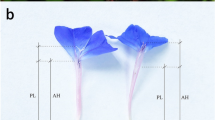Abstract
Seven clonal accessions representing all three stylar morphs of tristylous oca were intercrossed and selfed in a complete diallelic crossing design.
The four traits total capsule production, total number of seeds/capsule, total number of seeds containing an embryo/capsule, and percent seeds containing an embryo of all seeds per capsule were recorded. Both capsule and seed production were highest in the legitimate pollinations (in which styles are pollinated with pollen of the corresponding anther level), but also in illegitimate pollinations of mid-styled seed parents with long-level anther pollen of short-styled accessions.
All 18 types of pollination, consisting of 6 legitimate, 6 illegitimate intermorph, and 6 illegitimate intramorph pollinations, expressed gradually different levels of capsule and seed production.
Intramorph pollinations and selfs of mid-styled seed parents were less incompatible than intramorph pollinations and selfs of the long- and short-styled morphs.
All accessions studied expressed an intact system of heteromorphic stylar incompatibility despite their exclusive clonal propagation for millennia. A maximum of 16,3 seeds/capsule containing an embryo was obtained in an individual legitimate cross of two accessions, although an average of 25 ovules are present in a flower of O. tuberosa.
The results are discussed in relation to the establishment of a genebank based on botanical seed of this clonally propagated, valuable Andean tuber crop.
Similar content being viewed by others
References
Alandía Borda, S., 1967. —Producción de semilla sexual en oca. Sayaña, Revista Boliviana de Agricultura, La Paz, Bolivia 5(2): 12-15.
Barlow, N., 1913. Preliminary note on heterostylism in Oxalisand Lythrum. J Genetics 3: 53-65.
Cárdenas, M., 1984. Informe sobre los trabajos hechos en Bolivia sobre oca, ulluco y mashua. In: M.E. Tapia (Ed.), Avances en las investigaciones sobre tubrculos alimenticios de los Andes, pp. 5-21. PISCA IICA/CIID. é
Carrión, S., 1995. Biología reproductiva de la oca (Oxalis tuberosaMolina) y sus implicaciones para la producción de semilla botánica. Thesis, Catholic University of Ecuador, Quito, Eduador. 132 pp.
Castillo, R. & M. Hermann, 1995. Collecting Andean root and tuber crops (excluding potatoes) in Ecuador. In: L. Guarino, V.R. Rao & R. Reid (Eds.), Collecting Plant Genetic Diversity, pp. 639-646. Technical Guidelines. CAB International, Wallingford, UK.
Cortés, B.H., 1978. Avances de la investigación en oca. In: M.E. Tapia & M. Villarroel (Eds.), Memorias del l Congreso Internacional sobre Cultivos Andinos, pp 227-243. 25-28 Oct., dy1977, Ayacucho, Perú.
Darwin, C.R., 1877. The different forms of flowers on plants of the same species. Murray, London.
De Azkue, D. & A. Martinez, 1990. Chromosome number of the Oxalis tuberosaalliance (Oxalidacea). Plant Syst Evol 169: 25- 29.
Fano, H. & M. Benavides, 1992. Los cultivos andinos en perspectiva; producción y utilización en el Cusco. Centro de Estudios Regionales 'Bartolomé de las Casas', Cusco, Peru, International Potato Center, Lima, Peru. 86 pp.
Fisher, R.A. & K. Mather, 1943. The inheritance of style length in Lythrum salicaria. Ann Eugenics 12: 1-23.
Gibbs, P.E., 1976. Studies on the breeding systemof Oxalis tuberosa. Flora 165: 129-138.
Hermann, M., 1992. Andean roots and tubers: research priorities for a neglected food resource. International Potato Center, Lima, Peru. 36 pp.
Hodge, W.H., 1951. Three native tuber foods of the high Andes. Econ Bot 5: 185-201.
Leon, J., 1964. Plantas alimenticias andinas. Boletin Tecnico No. 6, Instituto Interamericano de Ciencias Agricolas, Lima, Peru.
Olson, R.A., 1988. Postpollination placental development of a dihaploid Solanum tuberosum. Can J Bot 66: 1813-1817.
O'Neil, P., 1994. Genetic incompatibility and offspring quality in the tristylous plant Lythrum salicaria(Lythraceae). Am J Bot 81: 76-84.
Ornduff, R., 1964. The breeding system of Oxalis suksdorfii. Am J Bot 51: 307-314.
Panti Pacheco, M., 1972. Introducción de la producción de semilla botánica para posibilitar la reproducción sexual con fines de mejoramiento en Oxalis tuberosaMol. (oca). Thesis Ing Agr, Universidad Nacional de San Antonio Abad del Cusco, Cusco, Perú. 67 pp.
Patiño, V.M., 1964. —Oxalis tuberosa. In: Plantas cultivadas y animales domésticos en América Equinoccial, Vol 2: Plantas alimenticias, Cali, Colombia, pp. 36-40.
SAS Institute Inc., 1985. SAS User's Guide: Statistics, Version 5 Edition. Cary, NC: SAS Institute Inc. 956 pp.
Towle, M.A., 1961. The ethnobotany of PreColombian Peru. Chicago. 180 pp.
Trognitz, B.R., 1995. Female fertility of potato (Solanum tuberosumssp. tuberosum) dihaploids. Euphytica 81: 27-33.
Valladolid, A., C. Arbizu & D. Talledo, 1994. Niveles de ploidía de la oca (Oxalis tuberosaMol.) y sus parientes silvestres. In: Resúmenes del VIII Congreso Internacional de Sistemas Agropecuarios Andinos, Valdivia, Chile, 21-26 March, 1994 (Abstract). AgroSur 22 (special issue): pp 11-12.
Vallenas, M., 1992. Fructificación, producción y viabilidad de semilla sexual en oca (Oxalis tuberosaMol.). In: VII Congreso Internacional sobre Cultivos Andinos, 4-8 Feb., 1991, pp. 255-258. La Paz, Bolivia.
Vuilleumier, B.S., 1967. The origin and evolutionary development of heterostyly in the Angiosperms. Evolution 21: 210-226Y.
Author information
Authors and Affiliations
Rights and permissions
About this article
Cite this article
Trognitz, B., Hermann, M. & Carrión, S. Germplasm conservation of oca (Oxalis tuberosa Mol.) through botanical seed. Seed formation under a system of polymorphic incompatibility. Euphytica 101, 133–141 (1998). https://doi.org/10.1023/A:1018336003573
Issue Date:
DOI: https://doi.org/10.1023/A:1018336003573




